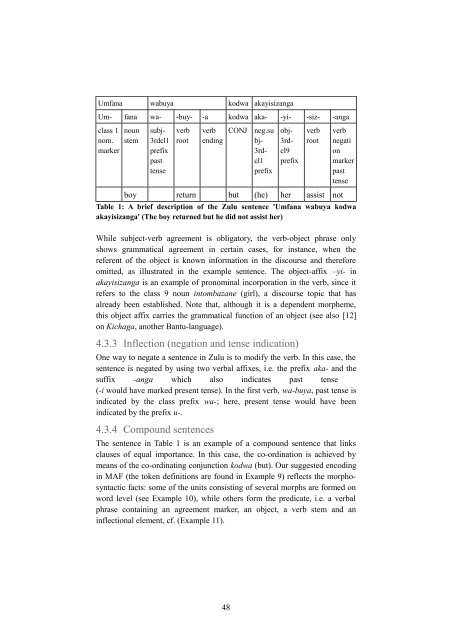A Treebank-based Investigation of IPP-triggering Verbs in Dutch
A Treebank-based Investigation of IPP-triggering Verbs in Dutch
A Treebank-based Investigation of IPP-triggering Verbs in Dutch
Create successful ePaper yourself
Turn your PDF publications into a flip-book with our unique Google optimized e-Paper software.
Umfana wabuya kodwa akayisizanga<br />
Um- fana wa- -buy- -a kodwa aka- -yi- -siz- -anga<br />
class 1<br />
nom.<br />
marker<br />
noun<br />
stem<br />
subj-<br />
3rdcl1<br />
prefix<br />
past<br />
tense<br />
verb<br />
root<br />
verb<br />
end<strong>in</strong>g<br />
CONJ<br />
neg.su<br />
bj-<br />
3rdcl1<br />
prefix<br />
obj-<br />
3rdcl9<br />
prefix<br />
verb<br />
root<br />
boy return but (he) her assist not<br />
verb<br />
negati<br />
on<br />
marker<br />
past<br />
tense<br />
Table 1: A brief description <strong>of</strong> the Zulu sentence 'Umfana wabuya kodwa<br />
akayisizanga' (The boy returned but he did not assist her)<br />
While subject-verb agreement is obligatory, the verb-object phrase only<br />
shows grammatical agreement <strong>in</strong> certa<strong>in</strong> cases, for <strong>in</strong>stance, when the<br />
referent <strong>of</strong> the object is known <strong>in</strong>formation <strong>in</strong> the discourse and therefore<br />
omitted, as illustrated <strong>in</strong> the example sentence. The object-affix –yi- <strong>in</strong><br />
akayisizanga is an example <strong>of</strong> pronom<strong>in</strong>al <strong>in</strong>corporation <strong>in</strong> the verb, s<strong>in</strong>ce it<br />
refers to the class 9 noun <strong>in</strong>tombazane (girl), a discourse topic that has<br />
already been established. Note that, although it is a dependent morpheme,<br />
this object affix carries the grammatical function <strong>of</strong> an object (see also [12]<br />
on Kichaga, another Bantu-language).<br />
4.3.3 Inflection (negation and tense <strong>in</strong>dication)<br />
One way to negate a sentence <strong>in</strong> Zulu is to modify the verb. In this case, the<br />
sentence is negated by us<strong>in</strong>g two verbal affixes, i.e. the prefix aka- and the<br />
suffix -anga which also <strong>in</strong>dicates past tense<br />
(-i would have marked present tense). In the first verb, wa-buya, past tense is<br />
<strong>in</strong>dicated by the class prefix wa-; here, present tense would have been<br />
<strong>in</strong>dicated by the prefix u-.<br />
4.3.4 Compound sentences<br />
The sentence <strong>in</strong> Table 1 is an example <strong>of</strong> a compound sentence that l<strong>in</strong>ks<br />
clauses <strong>of</strong> equal importance. In this case, the co-ord<strong>in</strong>ation is achieved by<br />
means <strong>of</strong> the co-ord<strong>in</strong>at<strong>in</strong>g conjunction kodwa (but). Our suggested encod<strong>in</strong>g<br />
<strong>in</strong> MAF (the token def<strong>in</strong>itions are found <strong>in</strong> Example 9) reflects the morphosyntactic<br />
facts: some <strong>of</strong> the units consist<strong>in</strong>g <strong>of</strong> several morphs are formed on<br />
word level (see Example 10), while others form the predicate, i.e. a verbal<br />
phrase conta<strong>in</strong><strong>in</strong>g an agreement marker, an object, a verb stem and an<br />
<strong>in</strong>flectional element, cf. (Example 11).<br />
48
















